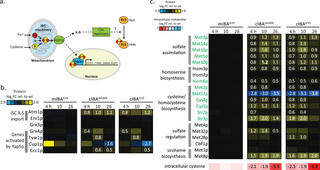Comparative functional genomics identifies an iron-limited bottleneck in a Saccharomyces cerevisiae strain with a cytosolic-localized isobutanol pathway
F. V. Gambacorta et al. "Comparative functional genomics identifies an iron-limited bottleneck in a Saccharomyces cerevisiae strain with a cytosolic-localized isobutanol pathway" Synthetic and Systems Biotechnology 7 (2022) [DOI: 10.1016/j.synbio.2022.02.007]
Metabolic engineering strategies have been successfully implemented to improve the production of isobutanol, a next-generation biofuel, in Saccharomyces cerevisiae. Here, we explore how two of these strategies, pathway re-localization and redox cofactor-balancing, affect the performance and physiology of isobutanol producing strains. We equipped yeast with isobutanol cassettes which had either a mitochondrial or cytosolic localized isobutanol pathway and used either a redox-imbalanced (NADPH-dependent) or redox-balanced (NADH-dependent) ketol-acid reductoisomerase enzyme. We then conducted transcriptomic, proteomic and metabolomic analyses to elucidate molecular differences between the engineered strains. Pathway localization had a large effect on isobutanol production with the strain expressing the mitochondrial-localized enzymes producing 3.8-fold more isobutanol than strains expressing the cytosolic enzymes. Cofactor-balancing did not improve isobutanol titers and instead the strain with the redox-imbalanced pathway produced 1.5-fold more isobutanol than the balanced version, albeit at low overall pathway flux. Functional genomic analyses suggested that the poor performances of the cytosolic pathway strains were in part due to a shortage in cytosolic Fe–S clusters, which are required cofactors for the dihydroxyacid dehydratase enzyme. We then demonstrated that this cofactor limitation may be partially recovered by disrupting iron homeostasis with a fra2 mutation, thereby increasing cellular iron levels. The resulting isobutanol titer of the fra2 null strain harboring a cytosolic-localized isobutanol pathway outperformed the strain with the mitochondrial-localized pathway by 1.3-fold, demonstrating that both localizations can support flux to isobutanol.
The mass spectrometry proteomics data have been deposited to the MassIVE database with the identifier MSV000088169. The transcriptomics data discussed in this publication has been deposited in NCBI's Gene Expression Omnibus under accession number GSE186126. Intracellular metabolomics data is available on GitHub. The full isobutanol pathway cassette sequence containing mitochondrial-localized enzymes and flanking HO arms is available on GenBank with the identifier MZ541859.
